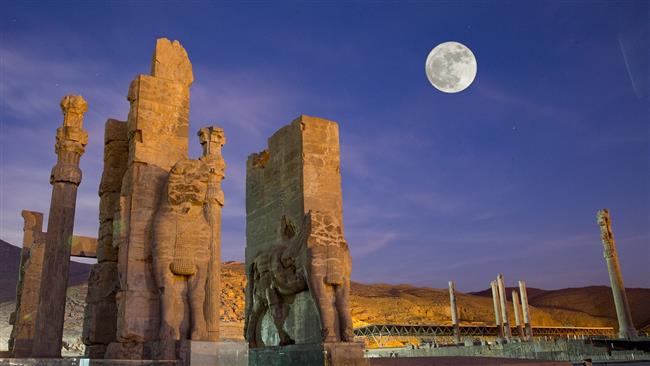Amazing supermoon lights up skies worldwide


A bright shining supermoon illuminated the skies around the world on Monday evening, creating a stunning view owing to the moon’s closest distance to planet Earth in the past seven decades.
A supermoon occurs when the moon becomes full on the same days as its perigee, the point in the moon’s orbit when it is closest to Earth.
NASA scientists say that supermoons generally appear to be 14 percent bigger and 30 percent brighter than other full moons.
The full lunar disc lighting up the night skies inspired people around the world, both professionals and amateurs, to try to capture the celestial event that will not repeat itself in almost two decades.
-

The moon is partly covered by clouds as it rises behind the statue of justice at Frankfurt’s famous landmark Roemer in Germany, November 14, 2016. (Photo by Reuters)
-

The supermoon is partly covered by clouds as it sets behind Wat Phrathat Doi Suthep in the northern capital of Chiang Mai, Thailand, November 15, 2016. (Photo by Reuters)
-

A passenger plane heading to Los Angeles International Airport passes by the supermoon Monday, Nov. 14, 2016. (Photo by AP)
-

Partially obscured by clouds, a full moon rises behind the monument of Christ of Havana in Havana, Cuba, Monday, Nov. 14, 2016. (Photo by AP)
-

A cloud drifts past as the full moon rises Monday, Nov. 14, 2016, in Lenexa, Kansas. (Photo by AP)
-

The moon rises behind the four business towers that mark the city skyline in Madrid, Spain, Monday, Nov. 14, 2016. (Photo by AP)
-

The moon rises behind the Propylaia at the Acropolis hill in Athens, Monday, Nov. 14, 2016. (Photo by AP)
-

The moon is seen with the International Commerce Centre building in Victoria Harbour in Hong Kong, Monday, Nov. 14, 2016. (Photo by AP)
-

The supermoon rises over Tehran in Iran, Monday, Nov. 14, 2016. (Photo by AP)
-

The supermoon is partly covered by clouds as it sets behind Wat Phrathat Doi Suthep in the northern capital of Chiang Mai, Thailand, November 15, 2016. (Photo by Reuters)
-

A passenger plane heading to Los Angeles International Airport passes by the supermoon Monday, Nov. 14, 2016. (Photo by AP)
Why is it called a Supermoon?
Experts in the field of astrology say that the moon’s orbit around the Earth is shaped like an egg and it is slightly irregular, so it moves closer or farther from us. However, the moon was at its closest point this cycle at 11:21 GMT on November 14, just 221,524 miles from our planet.
This phenomenon will be in records three times for 2016. The first one occurred on October 16 and the third one is expected on December 14, when the moon becomes full on the same day as perigee.
The second one, however, which happened on November 14, was not only the closest full moon of 2016, but also the closest full moon to date in the 21st century, making it an extra-supermoon.
Those who missed this phenomenon will not see another as such until November 25, 2034.
A supermoon is undeniably beautiful. And we can multiply that beauty by three as 2016 comes to a close.




